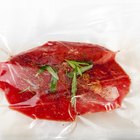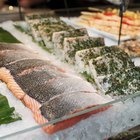Issaurinko/iStock/GettyImages
Buying at least some of your vegetables frozen, instead of fresh, is a smart strategy for busy cooks: Fresh produce will often spoil or deteriorate before you can cook it, but frozen vegetables are always ready when you are. You can even defrost frozen vegetables, turn them into prepared side dishes and then refreeze them, as long as you follow food safety guidelines.
Potential Issues
Thawing and refreezing food is something most cooks are trained to avoid, because of the risk of foodborne illness. That's a legitimate concern, because microorganisms have plenty of opportunities to grow in food as its temperatures change. You can plan for that by familiarizing yourself with good food-handling practices. A second concern is loss of quality through repeated defrosting. Again, there's a case to be made: Every time food is frozen, some damage to its cell walls is unavoidable, and therefore there's a loss of texture and moisture. You can minimize these unfortunate effects as well, though there will be some impact on the finished dish.
Defrosting Safely
Thawing your vegetables safely is the first step in the process. The best way to thaw anything is overnight in your refrigerator, which defrosts the vegetables gently and keeps them at a food-safe temperature from start to finish. If necessary, they can even stay in your fridge for an extra day or two before you cook them. You can also defrost safely in a cold water bath or the microwave, but these methods limit your options: Vegetables thawed in water should be cooked the same day, and those defrosted in the microwave must be cooked immediately.
Avoid Contaminating Your Vegetables
Vegetables pose less of a risk for foodborne illness than foods such as meats, fish and poultry, but that doesn't mean they can't provide a hospitable home to microorganisms. The biggest risk you'll face as you turn frozen vegetables into prepared meals is accidentally contaminating them. It's important to wash your hands, your utensils and your cutting boards or countertops every time you handle high-risk ingredients, including meats, fish and poultry. If you carry any of the juices from those foods back to your vegetables, there's a chance of introducing bacteria.
Cool Finished Foods Quickly
After you've cooked your frozen vegetables into finished dishes and they've begun to cool, the food safety clock starts ticking. As soon as their temperature drops to under 140 degrees Fahrenheit, the upper end of the food safety "danger zone," there's a chance bacteria can begin to grow in the food. Your cooked dishes should be divided into small batches or single portions, in shallow containers, and then refrigerated within two hours or less. They'll cool more quickly if they're left open and spread in a single layer rather than closed and stacked. You can cover them after they've cooled.
Freezing the Finished Product
After your vegetable dishes have reached refrigerator temperature, you're ready to refreeze them. Divide them into serving-sized portions and pack them into airtight containers or good-quality freezer bags. Air in contact with the food leads to freezer burn and shortened shelf life, so squeeze as much air as possible out of your freezer bags and press plastic wrap to the surface of any food in containers. Using vacuum food sealers is even better, because they extract more air. For vegetable dishes in sauce, which are difficult to vacuum seal, freeze them first in a container and then remove the "puck" of frozen food and put that into a sealer bag.
A Couple of Final Points
Food in containers, or food that's been frozen in a container and then moved to a bag, has the advantage of being uniform in size and shape and therefore easier to stack neatly in your freezer. That makes it easier to find and use the vegetable dish you're looking for at a given meal. However you package your food for the freezer, you should take a moment to label and date it so you know what it is and how urgently it needs to be used up. When you pull your food from the freezer at mealtime, it should always be heated to a temperature of 165 degrees Fahrenheit as a final step to maximize food safety.
Related Articles
Can We Refreeze Frozen Vegetables?

Guidelines For Refreezing

Can You Refreeze Shrimp That Has Been ...

What Is the Fastest Way I Can Defrost ...

What Happens if Meat Unfreezes and Then ...

Can You Freeze Canned Goods?
How Long After the Expiration Date Can ...

Rules for Thawing and Refreezing Meat

Can You Cook Frozen Foods That Are Past ...
Can You Freeze Shish Kabobs?

Which Vegetables Can Be Frozen?

How Long Is Leftover Spaghetti Good to ...

How to Store Dehydrated Foods

FDA Food Storage Temperature Guidelines

What Are the Best Containers to Freeze ...

How to Use a Probe Cooking Thermometer

How to Freeze Broccoli

How Long Can Cooked Salmon Last ...

Is It Safe to Cook Vegetables in ...

If Meat Is Frozen, How Long Does It ...
References
Writer Bio
Fred Decker is a trained chef and prolific freelance writer. In previous careers, he sold insurance and mutual funds, and was a longtime retailer. He was educated at Memorial University of Newfoundland and the Northern Alberta Institute of Technology. His articles have appeared on numerous home and garden sites including GoneOutdoors, TheNest and eHow.